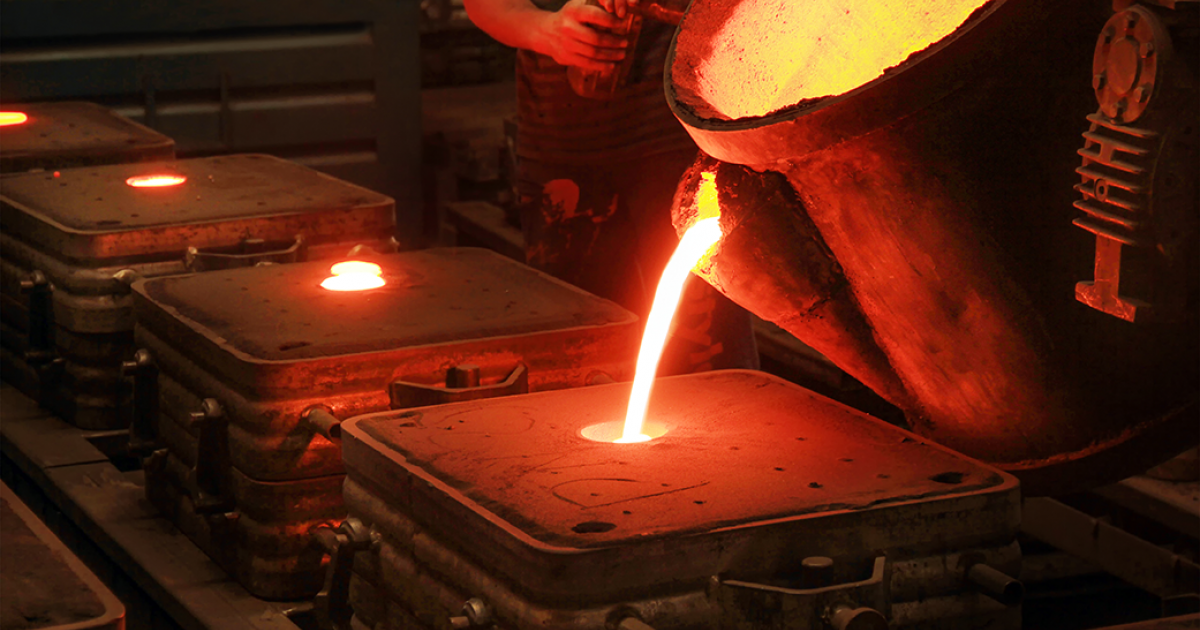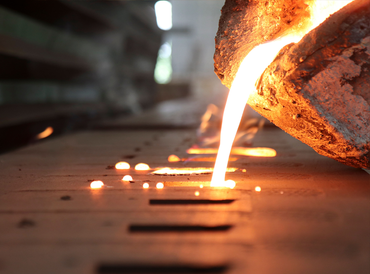Top Tips to Achieve High-Quality Aluminum Casting Results
All Regarding Metal Casting: Just How Foundries Deliver Top Quality and Precision in Production
Metal casting stands as a fundamental process in manufacturing, where raw steels are transformed into particular parts. Foundries employ numerous casting techniques to accomplish desired characteristics and shapes. Each technique features its very own set of limitations and benefits. Understanding these nuances is vital for valuing just how quality and precision are preserved throughout the process. The conversation in advance will explore the complex characteristics of metal casting and its importance across several sectors.
The Basics of Metal Casting
Metal casting is a basic procedure in manufacturing that entails forming liquified metal right into wanted types. This crucial technique begins with the option of raw products, frequently various metal alloys, which are melted in a heating system. When the metal gets to the ideal temperature, it comes to be liquid and ready for casting.
The procedure needs a mold, typically made from sand, metal, or ceramic, which specifies the last form of the actors object. When the molten metal is put right into the mold, it solidifies and cools down, taking on the mold and mildew's shapes.
After cooling, the casting is eliminated from the mold and mildew, and any essential ending up processes, such as cutting or polishing, are conducted. This method enables suppliers to generate intricate shapes and components with high precision and minimal waste. Metal casting is extensively made use of across numerous industries, from auto to aerospace, highlighting its relevance in modern-day production.
Sorts Of Casting Techniques
While various casting techniques exist, each technique uses distinct benefits and is fit for different applications. Sand casting, among the most typical methods, uses sand as the mold and mildew material, enabling for large components and complex styles. Financial investment casting, understood for its precision, employs a wax pattern coated in ceramic, making it ideal for intricate geometries. Die casting, which involves forcing molten metal into molds under high stress, is regularly utilized for mass production of tiny, detailed elements. Furthermore, shell molding incorporates sand and material to create thinner, much more accurate mold and mildews, enhancing surface area finish. One more approach, continual casting, makes it possible for the production of lengthy sizes of metal forms, simplifying production procedures. Each of these methods plays a crucial duty in the metal casting industry, attending to specific demands from production volume to develop complexity, thus adding to the diversity of applications across various fields.
The Duty of Foundries in Manufacturing
Foundries serve a vital function in the manufacturing landscape, as they change raw metals into usable components with various casting procedures. These facilities employ an array of strategies to produce items that meet specific specifications, thereby making certain high quality and effectiveness in manufacturing (Aluminum Casting). By making use of methods such as sand casting, financial investment casting, and die casting, factories accommodate diverse markets, including automotive, aerospace, and building

Inevitably, foundries are important to the production ecological community, supplying crucial components that sustain a large selection of sectors and applications. Their precision and adaptability drive efficiency in contemporary manufacturing.
Products Used in Metal Casting
The selection of materials used in metal casting is essential for achieving the preferred residential properties and efficiency of the end product. Different steels such as light weight aluminum, bronze, and iron are commonly employed, each offering distinct benefits. Aluminum is favored for its lightweight and corrosion-resistant high qualities, making it optimal for vehicle and aerospace applications. Iron, specifically cast iron, is known for its excellent fluidity and strength, suitable for heavy machinery and framework parts. Bronze, with its superior wear resistance, is often made use of in marine atmospheres.
In addition, materials such as silica sand are often made use of for mold production, supplying a great balance in between sturdiness and simplicity of shaping. The option of materials additionally consists of ingredients like fluxes, which enhance the casting procedure by enhancing fluidity and minimizing oxidation. Ultimately, the ideal choice of these products significantly influences the performance and high quality of the casting procedure.
Quality assurance in the Casting Refine
Quality control in the casting process is necessary to guarantee that end products satisfy market criteria and specifications. Different examination techniques are used to identify problems and evaluate the stability of cast parts. In addition, adherence to developed standards and accreditations improves the dependability and performance of cast materials.
Evaluation Techniques Employed
Keeping the stability of cast metal elements relies greatly on different evaluation strategies. Foundries employ aesthetic assessments as an initial measure to recognize surface area problems, such as fractures or additions. Non-destructive screening (NDT) methods, consisting of ultrasonic screening and radiographic examination, are crucial for discovering inner problems without jeopardizing the part's integrity. Dimensional assessments making use of calipers and coordinate measuring makers verify that parts meet specified resistances. Additionally, chemical analysis verifies that the alloy structure lines up with called for standards. These assessment techniques collectively verify that the castings fulfill the necessary high quality and efficiency criteria, eventually decreasing the risk of failing in their desired applications. Implementing these extensive assessments is basic for maintaining high criteria in metal casting production.
Requirements and Certifications
Requirements and qualifications play a critical function in the quality control of the casting process. Foundries follow various worldwide and industry-specific standards, such as ISO 9001 and ASTM guidelines, guaranteeing uniformity and reliability in their items. These requirements detail the needed requirements for materials, production techniques, and testing procedures, adding to an extra effective manufacturing process. Accreditations, such as AS9100 for aerospace applications, additionally stress the relevance of quality guarantee in specialized industries. By getting these qualifications, foundries show their dedication to quality, minimizing problems and enhancing client contentment. Regular audits and inspections verify compliance, cultivating constant improvement and development within the sector. Inevitably, adherence to established criteria cultivates trust fund between suppliers and customers.
Advancements in Casting Modern Technology

3D Printing Assimilation
Incorporating 3D printing modern technology into metal casting processes is changing the manufacturing landscape. This innovative fusion enhances the style and manufacturing of complicated geometries that standard approaches website struggle to attain. By using additive production for developing cores and mold and mildews, shops can greatly decrease lead times and product waste. 3D printing allows for fast prototyping, making it possible for producers to check layouts rapidly and efficiently, consequently assisting in repetitive renovations. This modern technology additionally sustains the production of light-weight parts, which are essential in sectors like aerospace and vehicle. Consequently, the combination of 3D printing not only improves procedures yet additionally raises the precision and quality of cast metal products, marking a noteworthy advancement in the industry.
Automated Production Processes
The improvements in 3D printing have led the way for more advancements in computerized production procedures within metal casting. Foundries are progressively taking on robotics and automation to improve efficiency and precision. Automated systems enhance the entire casting process, from mold and mildew development to putting and finishing. Smart sensing units and real-time monitoring permit for accurate control of temperatures and material circulation, reducing waste and boosting quality. Furthermore, software application solutions help with much better design and simulation, allowing suppliers to enhance procedures prior to production begins. These automated manufacturing processes not just reduce labor prices yet additionally minimize human mistake, making sure consistent result. Consequently, the combination of sophisticated innovations in metal casting is changing manufacturing abilities and fulfilling the growing needs of numerous sectors.
Advanced Product Development
As markets require greater efficiency and sustainability, advancements in material advancement for metal casting are becoming a critical emphasis. Engineers and scientists are exploring new alloys and compounds that boost mechanical buildings while lowering environmental influence. Innovations include light-weight products that keep toughness, making it possible for much better gas efficiency in transport applications. Furthermore, the consolidation of recycled products is ending up being extra widespread, straightening with sustainability goals. Advanced casting methods, such as 3D printing and precision molding, permit the creation of complicated geometries that standard approaches can not accomplish. These developments not only improve the functionality of cast parts but likewise improve production effectiveness. Generally, the continual advancement of material science drives the future of metal casting, satisfying the demands of modern markets.
Applications of Metal Casting Across Industries
Metal casting plays a necessary role in numerous industries, as it permits the production of complicated forms and high-quality parts with family member performance - Metal Foundry. In the vehicle industry, cast metals are crucial for producing engine blocks, transmission cases, and various other important parts that require sturdiness and precision. Aerospace markets make use of metal casting for components like generator blades and architectural aspects, where integrity is vital
Additionally, machinery and devices manufacturing gain from metal casting by generating equipments, real estates, and various other intricate parts that enhance performance. The building sector also uses metal casting for architectural functions, structural supports, and installations, showcasing adaptability.
Additionally, the clinical area depends on actors metals for medical tools and implants, emphasizing the demand for biocompatibility. Overall, metal casting is a fundamental procedure throughout multiple sectors, giving remedies that meet rigorous high quality criteria and performance demands.
Frequently Asked Questions
What Precaution Are Absorbed Metal Casting Foundries?
In metal casting factories, precaution consist of protective gear, air flow systems, normal tools upkeep, staff member training, and emergency situation protocols to mitigate threats related to heats, dangerous materials, and possible mishaps during the casting process.
How Do Foundries Handle Waste and Environmental Impact?
Foundries manage waste and environmental influence through reusing products, implementing filtering systems for exhausts, and adhering to guidelines - Metal Casting. They also take on sustainable methods, such as minimizing power consumption and utilizing green materials in their procedures
What Are the Expenses Related To Metal Casting Processes?
The prices related to metal casting procedures consist of raw materials, labor, tools upkeep, power usage, and waste management. In addition, variations in market value and conformity with ecological policies can significantly impact general expenditures for foundries.
How Does Metal Casting Contrast to Other Production Methods?
Metal casting supplies distinctive advantages, such as complicated shapes and high material efficiency, compared to approaches like machining or stamping. It might entail much longer lead times and higher first expenses, depending on job specs.
What Profession Opportunities Exist in the Metal Casting Market?
The metal casting sector offers numerous occupation chances, consisting of shop management, procedure design, quality guarantee, mold and mildew layout, and device operation. Professionals can additionally go after duties in research and development, sales, and ecological wellness and safety and security.
Metal casting stands as a foundational procedure in manufacturing, where raw metals are transformed right into specific components. Metal casting is an essential process in making that involves shaping liquified metal right into desired types. One more approach, constant casting, makes it possible for the manufacturing of lengthy sizes of metal forms, enhancing manufacturing processes. The costs connected with metal casting processes include raw materials, labor, equipment upkeep, energy usage, and waste monitoring. The metal casting sector supplies numerous job possibilities, consisting of factory management, process design, high quality guarantee, mold layout, and maker procedure.